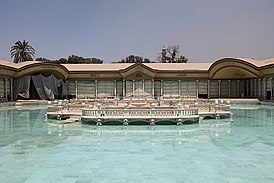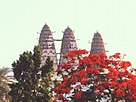Shubra El Kheima
Shubra El Kheima
شبرا الخيمة | |
|---|---|
    Clockwise from top: Shubrah Palace, Shubrah Palace Facade, Pigeon towers, | |
 Shubra El Kheima Location of Cairo within Egypt | |
| Coordinates: 30°7′43″N 31°14′32″E / 30.12861°N 31.24222°E | |
| Country | |
| Governorate | Qalyubia |
| Area | |
| • Total | 270.68 km2 (104.51 sq mi) |
| • Land | 270.68 km2 (104.51 sq mi) |
| Elevation | 16 m (52 ft) |
| Population (2012) | |
| • Total | 1,099,354 |
| • Density | 4,100/km2 (11,000/sq mi) |
| Time zone | UTC+2 (EST) |
Shubra El Kheima, (Arabic: شبرا الخيمة, IPA: [ˈʃobɾɑ lˈxeːmæ]) is the fourth-largest city in Egypt after Cairo, Giza and Alexandria. It is located in the Qalyubia Governorate along the northern edge of the Cairo Governorate. It forms part of the Greater Cairo agglomeration.
Demographics[]
Shubra El Kheima was primarily inhabited by workers (and their families), who have worked in surrounding factories since the 1940s. However, recently it contains the great expansion of Greater Cairo towards the north as a consequence of migration from rural areas. Its population was 1,016,722 at the 2006 Census. It is administered as two kism (wards):[1]
- 10.41 km2, 461,689 people, borders Nile River, with city railway station
- 17.27 km2, 563,880 people, inland, includes Bahtim
Since the national 2017 census, there is a 3rd kism (Al Khusus) within the governorate. It is unknown if this will be rolled into Shubra El Kheima or be considered a separate city, as municipal designations appears informal in Egypt. Using 2018 data (based on revised 2017 CAPMAS data projection), population of the two is 1,187,747 and 42,910 people per km2. The 3 kisms combined have 1,655,941 people with 46,764 people per km2.
Transportation[]
Shubra El Kheima is the northern terminus of Line 2 of the Cairo Metro.
Landmarks[]
Mohamed Ali Palace[]
Shubra El Kheima hosts the Palace of Mohamed Ali Pasha, the founder of modern Egypt. He chose an isolated palace or an official residence away from the Citadel in the district called Shubra, the construction of the palace began in 1808 and it was completed in 1821. The Palace of Mohammad Ali or Shubra Palace is distinguished by its style of decoration that mixes between the Islamic style of decoration and the European one.
Mohammed Ali's Palace is the first flourishing structures in Shubra. This palace was once involving about 13 building but the only remaining parts of it are the reception area, the fountain kios, the basin area and the garden that was provided with a collection of rare plants and some of them still exist and it is now a museum.
The palace finally came under the authority of the Supreme Council of Antiquities in 1978. The most remarkable one is the drawing room which was used a dining room, a small garden was planted in each step of this scalar hill which was irrigated the waterwheel tower that was constructed to provide the gardens and the villa with fresh water.
Gallery[]

Nightview from the train station

Shubra el-Kheima train station

Saint Theresa Church

Protesters during 2011 Arab Spring

Panoramic view of Shubra on the Nile
References and Notes[]
- ^ Population data taken from the City Population website Archived 2018-09-02 at the Wayback Machine.
External links[]
![]() Media related to Shubra El-Kheima at Wikimedia Commons
Media related to Shubra El-Kheima at Wikimedia Commons
- Districts of Cairo
- Districts of Greater Cairo
- Populated places in Qalyubia Governorate
- Metropolitan areas of Egypt







